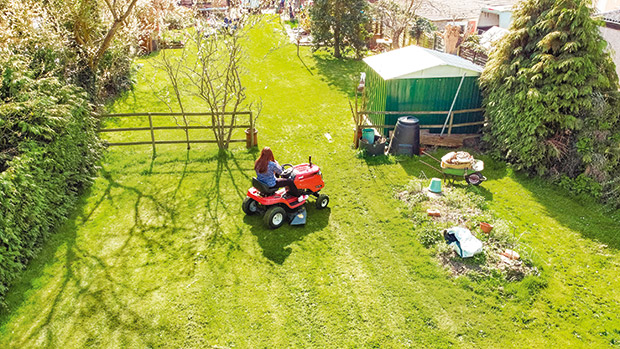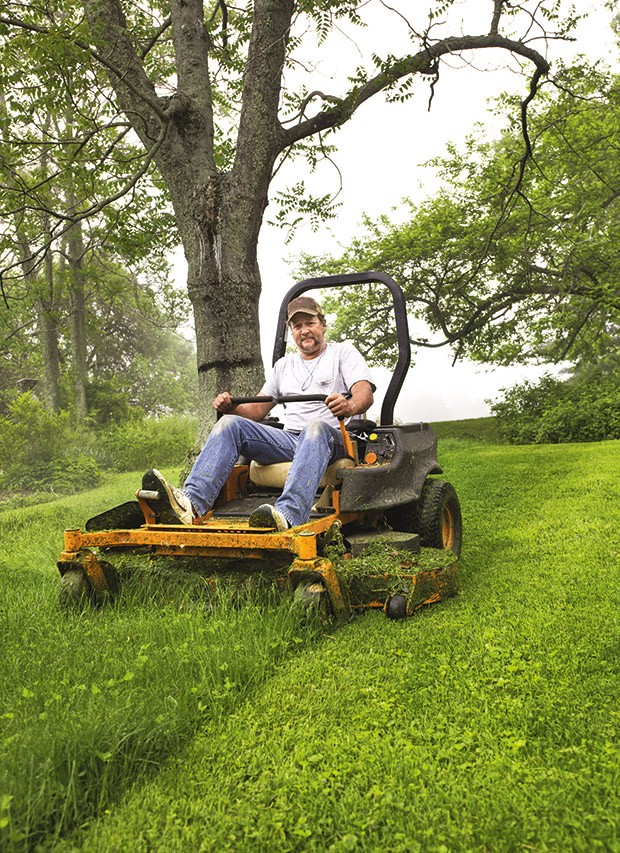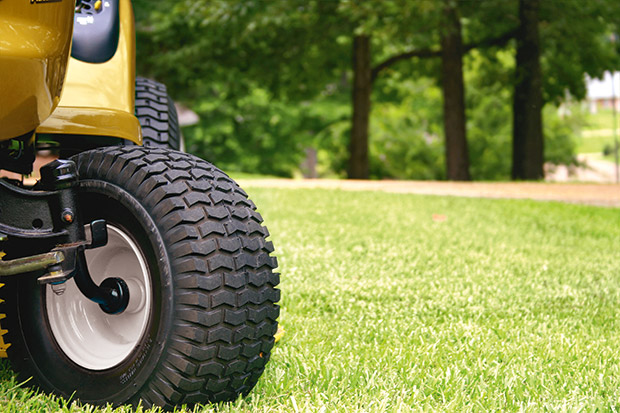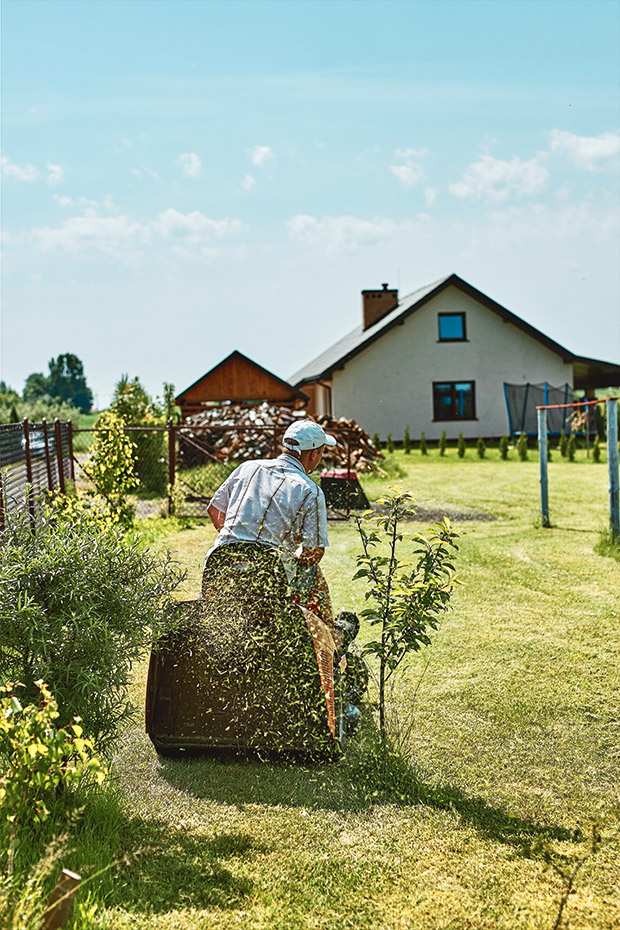How to find the perfect ride-on mower

They all mow grass, but there’s a science to finding the right one for your lawn.
Words: Nadene Hall
Ride-on mowers are designed to cut a large area of grass in the most efficient manner, but it’s crucial to match your lawn with the right style of machine.
1. THE ROUGH LAWN
What you need:
■ shaft drive;
■ differential or diff-lock;
■ robust deck, frame.
Many blocks have areas of rough, longer grass that don’t tend to get mown as often.
These frequently require a specialist machine with robust components, such as a stronger deck, heavy-duty engine, and shaft drive (instead of belts). Mowing thick grass places significant strain on a machine and requires a high torque engine to keep the blades spinning fast and the machine moving forward while mowing a heavy load.
The differential or ‘diff’ lock means you can lock one wheel in place and send all the forward power to the other, giving you significantly more traction if the mower gets stuck on rough terrain or goes up a slope.

2. THE BUSY LAWN
What you need:
■ tight turning circle
■ front-mounted deck
■ low centre of gravity
Zero-turn mowers are primarily designed for this type of lawn, relatively flat with lots of garden beds and trees. Instead of stopping, backing up and realigning the mower in and out of a tight area, you just spin around and head off.
This style can mow right to the edge of obstacles and run snugly along fencelines, so there’s little or no need to line-trim edges. Most models are also faster mowing in a straight line than a garden tractor.
A zero-turn mower can turn on the spot thanks to separate controls for each rear wheel. It’s incredibly fast compared to a steering wheel system.
The two levers used for steering, acceleration, and deceleration can look confusing compared to a car’s steering wheel. However the principle is the same as a supermarket trolley.
Forward: push both handles forward.
Reverse: pull both handles back.
Turn right: push the left handle forward.
Turn left: push the right handle forward.
Stop: bring both handles back to neutral.
3. THE STEEP LAWN
What you need:
■ high horsepower/torque;
■ low centre of gravity;
■ low weight distribution;
■ all-wheel drive;
■ differential-lock
This is the most challenging of all lawns in terms of safety. You need enough power to propel a machine up a slope and keep the blades turning. You also need one with its weight as low as possible so it’s less likely to tip.
Unless your mower’s instruction manual says otherwise, never mow a slope that’s greater than 15 degrees.
To find a slope’s angle, you can get an inclinometer app for your phone – most are free. Alternatives are to use a protractor or go to this link and scroll to the free printable download that will estimate a slope’s angle: www.osha.gov/dsg/riding_mowers/
4. PASTURE
What you need:
■ shaft-drive;
■ robust deck, frame.
Technically not a lawn, even though it’s a grassy area, but a lot of people want to cut both. Pasture is usually much rougher terrain with longer, thicker grasses, two things that place severe strain on a ride-on mower’s components.
One option is a cutting unit that you tow behind an ATV. These units are powered by a separate engine, can be pulled quickly over rough terrain, and cut tougher plants such as rushes.
However, the deck can be adjusted low enough to use on a lawn as well.

Is this the future of mowing?
Petrol or diesel-powered ride-on mowers are known for being noisy, around 90-95db or so. New electric ride-on mowers make around 70db (as loud as a washing machine) to 80db (a noisy restaurant).
Several manufacturers in NZ now offer electric ride-on mowers.
THE BATTERIES
There are two types of batteries:
Lithium-ion: cost more to buy than a lead-acid battery, lighter, can be fully discharged or partially charged without damaging it, can be recycled, will last 7-8 years.
Lead-acid: similar to the battery in your car, costs less than lithium-ion options, heavier, must be kept above 60-80% charge, lifespan is 3-5 years (in optimal conditions).
Electric ride-on mowers have similar transmissions and mowing speeds to standard ride-ons, but tend to be smaller, so they’re easier to manoeuver in tight spaces. There’s also no fuel or fuel storage, oil, belts, servicing, or engine maintenance.
Mowing time from one charge varies but is commonly around 1.5-3 hours depending on the grass length and the terrain. Commercial options can last many hours longer.
These machines usually have three or four low maintenance, highly efficient brushless motors (1-2 for driving the wheels, 2 for the blades).
Why mowers have cut-off switches
They might seem annoying, but there’s an excellent reason why ride-on mowers have a cut-off switch for reversing. US accident investigators found one of the most common causes of injury is an operator backing up and accidentally hitting a child. The others are a child being hit by a mower going forward, and falling off the mower. The average victim is a boy aged 7.5 years.
Questions to consider when buying a ride-on

1. Does it mulch?
One of the biggest nuisances is dealing with huge piles of rotting grass clippings. A ride-on mower with a mulch kit saves you the drama, plus it helps to keep your lawn healthy.
Tip: only cut grass back by a third when mulching. The clippings need a base of grass to fall into or you’ll see them sitting on the cut lawn.
2. Is it comfy?
You’re probably not thinking of comfort when you look at a mower, but different models come in a range of heights, with levels, pedals, and other controls.
Can you get on and off without hitting anything accidentally or twisting your body? Can the seat be adjusted to suit different body shapes/heights if multiple people will use the machine?
It can be a particular challenge if you’re short or tall to find a seated position that supports your back when you’re mowing for a long time.
3. What kind of finish do you want?
Some people don’t care about the look of their lawn. Others want an immaculate, carpet-like finish, but different ride-on mower designs deliver different quality cuts.
Most commercial, top-of-the-range ride-ons have out-front decks. These give a higher quality finish because small castor wheels at the front don’t crush the grass before it’s cut.
A mid-mounted lawn tractor tends to be cheaper but its tyres will crush the grass before it’s cut, affecting the finish.
Love this story? Subscribe now!
 This article first appeared in NZ Lifestyle Block Magazine.
This article first appeared in NZ Lifestyle Block Magazine.
